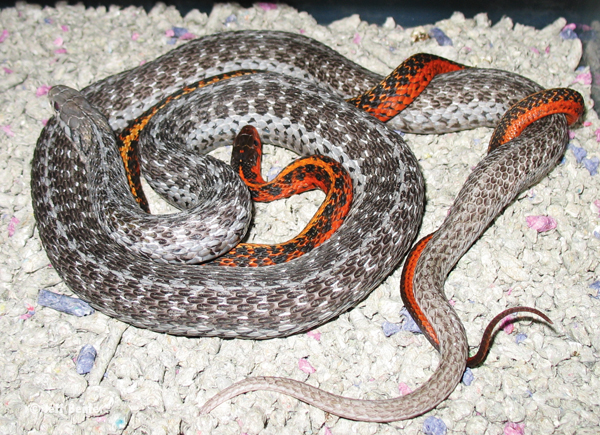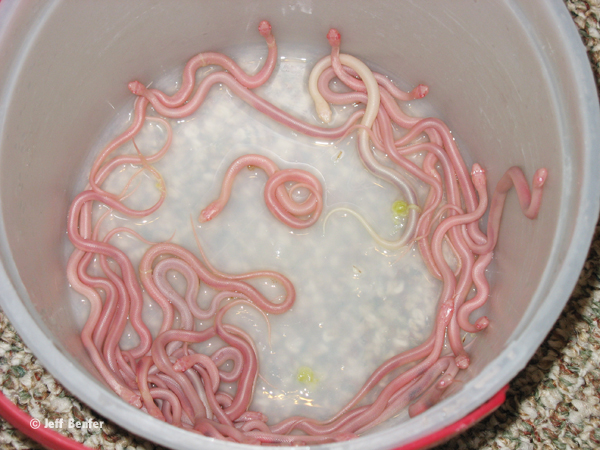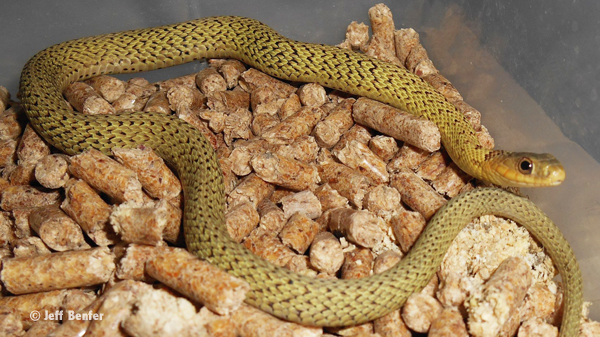Garter snakes are the most commonly found, scientifically researched and widely distributed snakes in North America. An interest in reptiles was ignit
Garter snakes are the most commonly found, scientifically researched and widely distributed snakes in North America. An interest in reptiles was ignited within many hobbyists when, as kids, they caught a garter snake in their backyard. Garters can be much more than just a beginner pet snake, however, and most people do not realize the plethora of garter snake “paint jobs” that are available in the hobby today.
Read More
Herping for Western Garter Snakes
Eastern Garter Snake Care Tips

jeff benfer
The California red-sided garter snake is a particularly attractive snake. This is a female.
Arguably the most curious and inquisitive of any snakes, the garters belong to the genus Thamnophis, with at least 35 species and numerous subspecies. Scientists are now able to utilize new technologies such as next generation whole genome sequencing, so there will likely be even more precise taxonomic distinctions made in the future. There are at least a dozen different species commonly available in the reptile-keeping hobby, including the checkered (T. marcianus), eastern (T. s. sirtalis) and Plains (T. radix) garter snakes, just to name a few.
Garters can be easy to keep and breed, but they have a very high metabolism. This is both a blessing and a curse. Being generally diurnal (active during the day) in combination with their high metabolism allows the keeper to observe their natural behavior. However, a high metabolism also means more frequent feeding and subsequently more enclosure cleaning is required.
Housing: A Tight Lid is Mandatory
Snake racks commonly used to keep other snakes can be used for garters, but the gap at the top of the tub may need to be shimmed with plastic toilet shims to avoid escapes, especially by babies or juveniles. Glass aquariums with secure screen tops or plastic terrarium-style enclosures are more popular with the average hobbyist because they allow good viewing of your pet. Well-constructed, tightly sealed, home-made wooden cages with screened front-facing windows also work well.

Jeff Benfer
A tight lid is mandatory when housing a garter snake.
Baby garter snakes should be kept in a small enclosure, so they will not have difficulty finding food and water. Adults should be kept in a minimum of a 29-gallon terrarium or a 28-quart tub. I think all keepers agree that the more space the better for adults, so a pair kept in a 40 gallon enclosure or larger would be ideal. Garters like to climb, and a branch or some vines will provide good exercise.
While garter snakes can be housed in small groups, it can make feeding time very challenging. Two snakes fighting over a food item can even lead to one of them trying to swallow the other, usually resulting in the loss of both snakes if not caught in time. I raise babies together by litters for the first few weeks of their lives before separating them. My adults are all housed separately in 28-quart tubs in racks for breeding simplicity, but if I only had a few pets I would keep them in a large terrarium in the living room.
There are many different types of wood- or paper-based substrates on the market that are typically used for colubrids, and they all work fine for garters. Pressed wood pellets, aspen shavings and reclaimed paper pulp substrates seem to work the best due to their absorption properties and are very popular with garter snake enthusiasts and breeders. Sand, clay litter, cedar or pine, and corn cob substrates should not be used.
Garter snake substrate should be kept dry, as too much moisture will cause blisters on a garter snake, which can be fatal if left untreated. It is important to maintain normal humidity of at least 30 percent to promote healthy skin shedding, while still maintaining good air circulation. The humidity level can be easily adjusted by covering part of the ventilated area(s) of the enclosure, top or sides, with a board or towel, or by taping over some of the air holes in a tub.
A water bowl large enough to allow the snake to submerge is preferred; my adult females coil up in theirs frequently before shedding. Garters are excellent swimmers, and while it is not necessary for them to be able to swim, some keepers enjoy watching this behavior. I see nothing wrong with providing a large swimming area if the enclosure size allows it, and as long as the water is kept pristine. I, however, prefer to use disposable, 16-ounce deli cups for water bowls; the water is replaced daily, and the bowls are replaced weekly.
A heat source such as heat tape or a heat lamp will aid in digestion and is essential for gestational development if breeding. Provide a temperature gradient across the cage, ranging from 85 to 90 degrees Fahrenheit on the hot side of the enclosure where the heating element should be concentrated, to room temperature at the other end of the enclosure.
Feeding Garters
Garter snakes are the perfect pet snakes for people who don’t like the idea of feeding live rodents. In the wild they feed mainly on fish, earthworms, frogs and toads, but will opportunistically eat small rodents, as well. Night crawlers, earthworms and frozen/thawed rodents of appropriate size make excellent staple foods for pet garter snakes.
It is best to feed young garter snakes in a separate, bare-bottomed feeding enclosure, to avoid any possible swallowing of substrate in their primary enclosures that may cause impaction. Never feed composting worms (aka “red wrigglers” or “trout bait worms”), as they are toxic to garter snakes. Fish can be offered, as either cut strips or whole small fish. Feeder fish such as goldfish or “rosy reds” (both readily available at most pet shops) contain an enzyme called thiaminase, which breaks down thiamine (vitamin B1), and long-term exclusive feeding of these fish should be avoided. Otherwise, you may put your snake at risk of a potentially fatal vitamin deficiency. Garters do not eat crickets, mealworms or other insects.
I prefer to feed frozen/thawed mice and night crawlers, for both ease and complete nutrition. Yearling snakes typically eat frozen-thawed fuzzy mice and whole large night crawlers. Adult garters eat small, adult frozen/thawed mice. They seem to prefer the smell of hairless mice, and those slide down real easy, but these are not readily available in local pet stores (though there are online sources). All food items can occasionally be dusted with a vitamin and mineral supplement that contains calcium and vitamin D3.
By adulthood, most of my snakes are conditioned to eat directly from tongs, which dramatically speeds up the process for a larger snake collection. They would certainly eat directly from my hand, but sometimes pink fingers can be mistaken for pinky mice, so I prefer to use the tongs. Alternatively, food can be placed on a dish and left for the snake to find using its keen sense of smell. Garters rely on sight and smell to find food; they do not have heat sensory pits like other snake species such as boas and pythons. They do not constrict their prey—they just grab hold and swallow.
Brumation
It is not necessary to brumate during the first winter of a garter snake’s life, and I would not recommend it, because brumation losses are common even among healthy adult snakes. Brumation can be especially hard on small, weak or thin snakes. It is not necessary to brumate adult garters if you’re not going to breed them, but they may still become less active and stop feeding for a month or two during the winter anyway.
Adult garters should be prepared for brumation with frequent heavy feedings in the fall, prior to stopping feeding several weeks prior to brumation to clear out the snake’s digestive tract. Undigested food that remains during brumation will rot, make the snake sick and can even cause death.
Brumation should be done in a dark, cool area—ideally, one that is 45 to 60 degrees—for several months during the winter. An unheated area in a basement works well. Alternatively, an old refrigerator with the door kept ajar works, too.
Tips for Breeding Garters
Breeding garter snakes is similar to breeding most other colubrids. After brumation, I like to get at least one good meal in them before pairing them up. Only one breeding event per year is often necessary if both the male and the female are properly cycled and in good breeding shape. However, it is good insurance to rotate males through the females several times over the course of a month or two just to be sure the job gets done.

Jeff Benfer
Pictured here is an erythristic eastern male garter breeding with a larger female silver estern.
It is usually a good sign when a female starts to remain coiled on the hot side of the enclosure. Pregnant females will also develop a ravenous appetite; they will practically demand that you feed them a little more frequently. It is important, however, to not overfeed them, as they can become unhealthily obese.
After a month or so, a pregnant female will plump up and her scales will begin to separate, both signs that she is full of babies. Rather than laying eggs, gestation occurs inside the female, taking approximately 60 to 90 days before the babies are born. It is quite a sight to open a cage one day and see a dozen or more little heads looking up at you! Garter snake litters average 10 to 20 babies; however, large litters two or three times this size are not uncommon. My snakes have had several litters that contained more than 40 babies, which can be quite an overwhelming shock in the morning when you are trying to get ready to go to work!
Garter snakes are ovoviviparous, in that the eggs are fertilized and then incubated inside the female. Baby garters leave the female fully developed, a process called parturition. They actually emerge into the world inside a little bubble called a birth or amniotic sac, from which they have to poke their way out to take their first breath. I have had the pleasure of witnessing this on several occasions, and have even helped several little scrubs that were struggling to break out.

Jeff Benfer
Garter snakes are ovoviviparous, in that the eggs are fertilized and then incubated inside the female. Baby garters leave the female fully developed, a process called parturition. These are Iowa snow Plains garter snake young.
Sometimes a birthing event may include a couple underdeveloped babies and/or unfertilized eggs, commonly called “jelly beans.” If you are fortunate enough to get a litter of nothing but healthy babies, consider yourself lucky. Baby garters shed the same day they are born, usually within minutes of leaving the amniotic sac. The sheds are so thin and tiny that they easily disappear in the substrate, leading inexperienced breeders to overlook them and assume the babies haven’t shed yet.
Most baby garter snakes will eat approximately a week after they are born. Keeping the entire litter together in the same tub for the first few meals is fine. With a sharp scissors, cut baby night crawlers (aka “dillies”) into pieces that are about the size of the snake’s head, about three-eighths of an inch in diameter. Then place the pieces in a small plastic bowl, such as a 1½-ounce scuffle cup made by Dart. Put two to three pieces per snake in the cup, and place it in the tub with the litter. Leave the babies undisturbed for at least 30 minutes, or even overnight. After one snake starts eating, the rest should follow and a feeding frenzy will ensue.
This type of group feeding works well for the first few feedings, but then it is best to separate the babies so larger pieces of night crawlers can be fed. It’s not a problem when you’re feeding them bite-sized pieces that are quickly swallowed, but if you feed larger pieces to a group, you run the risk of two snakes starting to swallow at each end of the piece of worm—and one snake may keep on swallowing even once it’s reached the other snake. Dillies are readily available at big box stores, but alternatively you can collect earthworms or night crawlers from your yard after a good rain, provided you do not use pesticides or other potentially harmful substances on your lawn.
Baby garter snakes will grow quickly if fed twice a week. Within a month, start mixing chopped pinky mice in with the cut night crawlers. After a few of these “mixed” feedings, the snakes can usually be switched over to chopped pinkies entirely. After a couple months you can stop cutting and chopping; by then, your snakes should accept whole day-old, frozen/thawed pinky mice or full-sized night crawlers.
Paint Jobs
Many colors and patterns are available within naturally occurring garter snake species and subspecies; top those off with all the color and pattern morphs that have resulted from captive breeding, and garter snakes just might display more color and pattern diversity than any other snake genus on the planet.

jeff benfer
Golden eastern garter snake.
Garters display all the colors of the rainbow, literally. A “blue” garter means ultramarine blue, not the so-called blue that is more of an iridescent gray. Red garters are fire-engine red, not some muted orange-brown color. Melanistic garters are jet black, not dark brown.
Garters exhibit checkerboard patterns, stripes, solids and granites with irregularly shaped spots. There are even piebald and scaleless types. Without argument, garter snakes really do display some of the best “paint jobs” of any snakes in the world.
Just Do It
Garter snakes are an ideal pet reptile, and a couple of brightly colored garters snakes in a planted terrarium can make a beautiful display. They are not intimidating, and their bite isn’t painful and rarely draws blood. They are very low maintenance, and if you acquire a captive-bred baby and handle it regularly as it grows, it will calm down and not musk during handling (see sidebar). A garter snake will often come to enjoy being out of its cage while being handled. Garters are very inquisitive by nature, and they seem to have an almost playful nature.
A docile smaller snake that isn’t likely to scare your neighbors, has a gorgeous paint job, is inexpensive and easy to keep, with real personality and that is fun to watch—what’s not to love about a garter snake?
Jeff Benfer has kept garter snakes and many other reptiles and amphibians for more than 40 years. He has successfully bred many different types of garters, written several articles about them, and discussed them twice on Reptile Radio. He produced the world’s first snow red-sided garter snake in 2009 and dozens of other unique garter snake combination morphs. He has degrees in fine art, biotechnology and biochemistry and is currently working on completing a master’s degree in epidemiology.


